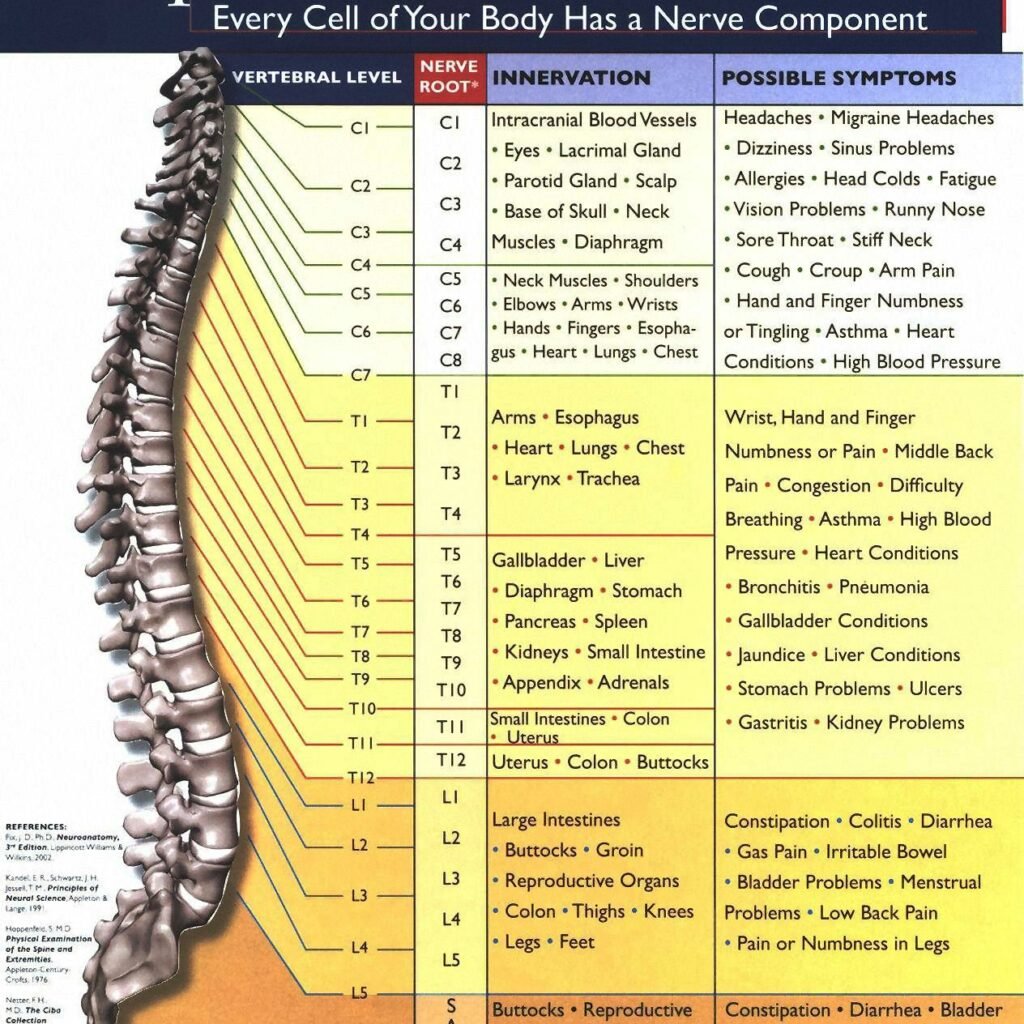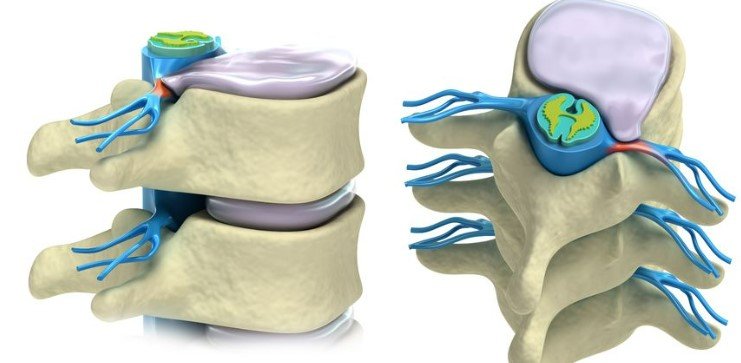Alive Blog
The intervertebral discs
Precious jelly between our spine bones
“I slipped a disc”, “I have a disc issue”. “I herniated/popped a disc”, “A disc just went”, “I have degeneration of one of the discs”, “They diagnosed me with Degenerative Disc Disease”. These are expressions that we – as chiropractors – sadly hear all the time. It’s time to give you an overview of what these “discs” are, why mother nature equipped us with 23 of them between each vertebra and – most importantly – why they are so precious.
Anatomy of the intervertebral discs
First thing first, let’s start with the anatomy. The intervertebral discs are circular shaped structures found between each vertebra of your spine. We have 5 cervical vertebrae (C1 to C7), 12 thoracic vertebrae (T1 to T12) and 5 lumbar vertebrae (L1 to L5). The vertebrae change in shape and size according to their location. As an example, L5 is way bigger than C3. They also differ in other ways: the cervical and the lumbar vertebrae move better in extension, while the thoracic ones move better into flexion. The thoracic vertebrae have also another unique characteristic, they provide an anchor point for each rib (our rib cage has 12 ribs, “attached” at the back to the 12 thoracic vertebrae).
Each vertebra is linked to the previous and the next thanks to a complex network of ligaments, muscles and tendons. And also, intervertebral discs. The anatomy of an intervertebral disc consists of several components. Starting from the inside, we find the “Nucleus polposus”. This represents the core of each disc: it is literally a gel like substance which is capable to exhibit shock absorbing properties, allowing the disc to be “squashed” under a load or under compressive forces. Moving towards the out part of the disc, we find the “Annulus fibrosus“, which in Latin means “fibrous ring”, and it is exactly like it’s called. t is composed of concentric layers of fibrous tissue arranged like rings of a tree. This fibrous structure provides strength to the disc and helps contain the inner gel-like material (the nucleus pulposus).
Every disc is composed by these two main structures. Each of them also changes in size, thickness and diameter, according to its position along the spine (also, did you know that discs are thicker in the morning and thinner in the evening? That’s because while we sleep, discs get hydrated and regain thickness while you sleep).
Going forward, we can notice other important structures which are not part of the disc itself, but which are strictly related to it. I am talking about the “Intervertebral foramen” (see picture below). As you can notice from the picture, the wider and more “hydrated” the disc, the wider will be this space. The narrower the disc, the smaller the “intervertebral foramen”. And guess what comes out from the intervertebral foramen of each and every vertebra? Yes, that’s right. Nerves.

Spinal nerves
Each and every nerve that comes out from your spine, supplies a particular organ, muscle, skin area, etc. Take a look below:

Literally, every function of your body depends on the spinal nerves. All of them. If – let’s say – there is a serious problem on the nerve root coming out between C7 and T1, it is very likely that the patient will experience numbness or tingling in certain areas of the hand. If the problem is bad enough, there could be muscle weakness impairing certain movements and inhibiting certain reflexes. Just to give you an example, we maintain a vital function like breathing because the main muscle of respiration – the diaphragm – is controlled by a nerve (the phrenic nerve) forming by C3, C4 and C5 nerve roots (at college they used to say C3, C4 and C5 keeps the diaphragm alive). Not only, but spinal nerves reach organs in the body, like kidneys, adrenal glands, large intestine and so on.

What can go wrong and what to do to maintain healthy discs
You can now start to get an idea of how important these discs are and how crucial it is to maintain them healthy.
We evolved as a species to live, walk and run by being on two legs and unfortunately, there is not much we can do to counteract the weight of gravity on our spines (apart from getting adjusted by a chiropractor at least once a month).
Most of our problems – however – do not come from the fact we are standing, but arise from sitting. Sitting is a silent and comfortable killer for our spine. We sit way too long, full stop. So many studies have been conducted which show how sitting puts from 60 to 80% more pressure on our discs than a standing position. When we sit, our body weight does not have anywhere else to go than our discs (mostly the lumbers). Differently, when we stand our body weight is distributed onto our legs; ideally, 50% on the left leg and 50% on the right.
Discs pathologies
When a disc gets thinner, or dry or dehydrated, we call it Degenerative Disc Disease. Unfortunately, when this stage is reached, there is not so much that can be done. Some spinal traction techniques can help alleviate the discomfort. Surgery is in most of the cases pointed towards the direction of inserting an artificial “spacer” between two vertebrae. Recent experimentation with stem cells seems to be very effective (also very expensive). THIS is one of the most popular centre that does stem cells nowadays.
Another very common pathology is the “Disc herniation”. There are a number of factors that can contribute to a disc herniation such as being overweight, having a weak core musculature, being sedentary, or moving improperly. This is obviously not an exhaustive list.
Disc herniations can very in severity and sometimes – in their mildest form – they can be called “disc bulges”. A bulge is not as severe as a herniation but it can still cause lots of troubles. On the other hand, herniation too can vary in type, degree and severity (for a full overview on this last point, please visit this LINK).
Maintaining a healthy spine and healthy discs
Posture
In a world dominated by screens and desks, the importance of maintaining good posture often slips our minds. Yet, the way we hold ourselves massively affects the distribution of weight on our intervertebral discs. Picture yourself standing tall, shoulders relaxed, and chin slightly tucked. This natural alignment reduces undue stress on the discs, allowing them to bear the load harmoniously. When seated, visualize your spine as a string of pearls, each vertebra gently stacked atop the other (but please – sit less as possible! Buy a standing desk and sit when you need to rest). If for any reason you can’t stand, employ ergonomic chairs and proper desk setups to discourage slouching and encourage optimal alignment.
Movement
Life is movement, and your spine is the orchestra director. Engage in regular physical activity to keep the discs well-nourished and the muscles supporting your spine strong. Engage in a mix of cardiovascular exercises, like walking or swimming, and strength-building routines, such as yoga or weight training. These activities not only maintain spinal health but also enhance overall well-being by promoting circulation and releasing feel-good endorphins. Variety = longevity, so mix things up!
Nutrition
Just as a sculptor selects the finest materials for their masterpiece, you can select nourishing foods to support the health of your intervertebral discs. Consume a balanced diet rich in vitamins and minerals, especially calcium and vitamin D, to promote bone health. Incorporate omega-3 fatty acids, found in fatty fish like salmon, as they possess anti-inflammatory properties that can benefit your spinal discs. Hydration, too, is vital—water provides the fluidity necessary for the nucleus pulposus to maintain its shock-absorbing qualities.
Mindfullness
Life’s pressures can often manifest physically, affecting our muscles and, consequently, our spinal health. Cultivate mindfulness practices, such as meditation and deep breathing, to ease stress and reduce muscle tension. Stress-induced muscle contractions can strain the discs and lead to discomfort. By learning to navigate life’s challenges with calmness and poise, you’re safeguarding the health of your spine.
Maintenance
Just as an antique collector cares for their treasures, engage in preventive maintenance to ensure your spinal health endures. Regular chiropractic check-ups and adjustments will help address minor issues before they become real problems. Engage in low-impact exercises like swimming or walking, which strengthen the muscles supporting your spine while minimizing impact on the discs themselves.
Rest
Every masterpiece requires moments of reprieve, and your spine is no different. Adequate sleep is essential for your body to repair and rejuvenate. Invest in a sleep-friendly environment, complete with a mattress and pillows that encourage proper spinal alignment. If you’ve had a particularly strenuous day, consider a warm bath or gentle stretching before bed to soothe muscles and alleviate tension on the discs.
For how long do I have to do the above?
As the chapters of your life unfold, your commitment to maintaining healthy discs in your spine remains steadfast. Just as a gardener tends to their plants with care, you nurture your spine through thoughtful choices. Remember that your spine is the pillar upon which you build your own life, and by cherishing its health, you ensure that your life long, vibrant, and free from unnecessary pain.
Edoardo Elisei DC
Alive Chiropractic LTD
alivechiropractic.co.uk
1C Crown Gate Square
POUNDBURY
01305602314
22/8/2023
Alive Chiropractic Poundbury
1C Crown gate square DT1 3EJ
Poundbury, Dorchester
Phone Number
01305602314
07845096314
